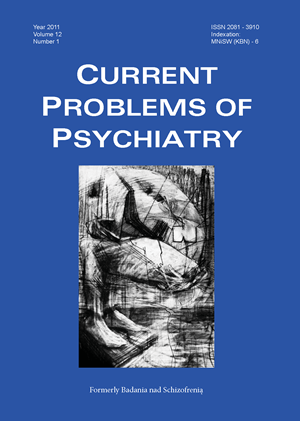Symbolism of eye and looking In drawings of Edmund Monsiel with Wożuczyn
Keywords:
psychopathology of expression, Edmund Monsiel, schizophrenic artistic expressionAbstract
In Christian art the eye surrounded by rays denotes the Creator; the eye in a triangle is God the Father in the Holy Trinity. In the Bible an eye is a symbol of omniscience, watchfulness and protective omnipresence of God. In the symbolism of the art of Native Americans the eye can see everything, it penetrates our life and it is also the mirror of conscience, death. The Eyes of God are also a testimony, the windows of a soul, and thus of the eternity. In prehistoric art of Egypt they are outlined and ornamented in sculptures and paintings. In creative activity of distinguished painters, the motionless and solidified eyes, sometimes even without pupils in Modigliani’s paintings, are catching the attention. In the iconographic paintings eyes and gaze play an important role in representations of Christ, The Blessed Virgin and the Saints, important for the tradition of eastern Churches. Persons with schizophrenic disorders attach great importance to a gaze and perceive an imaginary power of eyes with a particular sensitiveness. The symptoms appear with conviction that people look somehow strangely at patients. It creates an impression that other people want to hypnotize them, get to know their thoughts and next, take possession of them. Eyes in the paintings of people with schizophrenic disorders are usually emphasised and particularly marked. They are frequently motionless, solidified; sometimes goggle with an empty place for a pupil. There may be more than two eyes, they may occur separately, beyond a face, becoming somehow distinct beings. In Monsiel’s creative art missionary belief is clearly indicated, God manifests His multiplied presence throughout these multi-directed-penetrating eyes.
Monsiel was convinced that he knew about the world more than others, mainly about its bad sides. Eyes in his pictures, like in many representations included as schizophrenic expression of art, are most often bolded, outlined and have pupils. There are no lashes but empty eyesockets, eyebrows are usually outlined a well. Eyes which are most frequently the elements of the author’s face may be also received as dangerous, threatening, imperative, tracing and watchful. In Monsiel’s pictures the gaze of hundreds of multiplied faces is directed to the different sides, forward, downward, aside and upward. Eyes centrally located direct the gaze ahead, toward an audience. Faces located en face direct their gazes ahead. This representation of dozens and hundreds of faces and of eyes creates the expression of their omnipresence. The analysis of Edmund Monsiel‘s pictures and their symbolism hidden in the thick of faces, gazes and weird settings of figures, seems to be still incomplete and not giving, even in a part, intentions of the author, which we may not solve till the end despite great knowledge about schizophrenic expression of art, output of History of Art and related fields.
References
1. Leksykon symboli Herder, Wydawnictwo ROK Corporation, Warszawa, 1992.
2. Cirlot J.E. Słownik symboli. Kraków; Znak: 2006.
3. Madejska N. Malarstwo i schizofrenia. Warszawa; WL: 1975.
4. Sama choroba talentu nie tworzy. Rozmowa z Ignacym Trybowskim. Pismo, 1983; 9.
5. Prinzhorn H. Artistry of the Mentally Ill. Wien, New York; Springer-Verlag: 1995.
Downloads
Published
Issue
Section
License
Copyright (c) 2011 Authors

This work is licensed under a Creative Commons Attribution-NonCommercial-NoDerivatives 3.0 Unported License.


